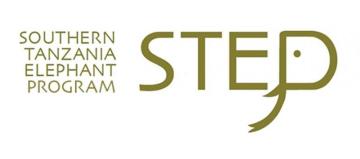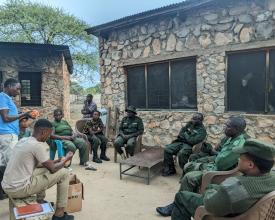
Effective Human-Wildlife Conflict Mitigation in MBOMIPA Wildlife Management Area through Community-Led Response Teams
Funded by BIOPAMA and implemented by the Southern Tanzania Elephant Program (STEP) and MBOMIPA Wildlife Management Area (WMA), this project enhances Human-Wildlife Conflict (HWC) management in the Ruaha-Rungwa ecosystem. Established in June 2023, MBOMIPA's first HWC Response Unit comprise of 12 Village Game Scouts – VGS (40% women) + 2 drivers tackles human-elephant conflict (HEC) using non-lethal deterrents (HEC Toolkit, Noisy Balls) and EarthRanger technology. The unit responds to community alerts, protecting crops while ensuring elephant safety. Challenges addressed include recurring crop losses (averaging 2.3 incidents/farm/year) and farmer-wildlife tensions. Results show 176 incidents managed in 2023-2024 with 68.8% prevention rate, zero elephant fatalities, and 89% farmer satisfaction.
Context
Challenges addressed
This project addresses HEC challenges in MBOMIPA WMA, where crop damage caused by elephants threatens both wildlife and community livelihoods (averaging 15 incidents per month in a village) faced retaliatory killings (2 elephants/year) pre-project, disrupting ecosystem balance. The negative interactions between farmers and elephants frequently lead to crop loss and food insecurity, exacerbated by increasing encroachment near WMA boundaries. These conflicts undermine local economies and strain social relations between communities and conservation stakeholders. The HWC Response Unit specifically targets these challenges by reducing crop losses while protecting elephants, addressing the competition for resources that intensifies human-wildlife conflicts.
Location
Process
Summary of the process
The building blocks of the HWC Response Unit Training, Community Alert System, and EarthRanger Integration interact synergistically to create a comprehensive and effective HWC mitigation strategy. The HWC Response Unit Training forms the foundation by equipping scouts with the skills and tools needed to safely and effectively deter elephants, while the Community Alert System ensures rapid reporting and coordination between farmers and responders, enabling timely interventions. These two components are further strengthened by EarthRanger Integration, which enhances data collection, real-time tracking, and strategic decision-making, allowing for more efficient resource allocation and incident management. Together, these elements create a feedback loop: community alerts trigger rapid response, response actions are recorded and analyzed via EarthRanger, and insights from data inform future training and patrol strategies. This interconnected approach not only improves immediate conflict resolution but also builds long-term trust between communities and conservation efforts, ensuring sustainable coexistence between humans and wildlife.
Building Blocks
Human Wildlife Conflict Response Unit Training
STEP and Honeyguide Foundation facilitated training at MBOMIPA WMA to equip 12 VGS (40% women) + 2 drivers with effective techniques for safeguarding community farms from elephant damage. The training equipped Scouts with knowledge on elephant behavior and how to use the HEC toolkit (torches, horns, chili crackers, and roman candles) to push elephants away from farms. Participants also learned techniques for safely relocating elephants based on their behavior and group composition (namely, whether they were all-male, all-female, or mixed groups). Refresher trainings have been regularly provided to the team to ensure safety.
Enabling factors
Key conditions enabling success of the training include:
- Support from expert trainers: Experts from Honeyguide foundation facilitated the training achievement, as they had knowledge on the use of HEC toolkit and elephant behavior.
- A dedicated HWC Response Unit: Readiness of the response team to learn and enhance their capacity at handling HEC contributed to the achievement of the training provided to them.
- Access to fund: Availability of fund for the training and learning materials such as deterrent tools
Lesson learned
The training and tools provided to the HWC Response Unit played a great role in the successful management of the reported HEC incidents in Pawaga Division. The training equipped the Unit with knowledge of elephant behavior as well as the logic behind elephant deterrents and sequential use of the toolkit. This enhanced the ability of the team to respond to HEC incidents in an effective and safe manner.
Resources
Community Alert System
The three-tier community alert system enables rapid reporting of HEC through established communication channels. Farmers immediately contact VGS via dedicated phones when elephants approach farmlands, while village chairs serve as secondary contacts to verify and escalate critical incidents. This decentralized structure ensures 24/7 coverage across member villages, with response prioritization based on crop vulnerability and elephant herd size. The system incorporates community feedback loops, where farmers receive call for confirmations of Response Unit coming and after incident resolution farmers discuss the incident with the Unit, building trust in conservation efforts.
Enabling factors
Key conditions enabling success for community alert system include:
- Pre-existing mobile network coverage in villages
- Annual community training on alert protocols (conducted in Swahili) during MBOMIPA Cup, communication material, and meeting with WMA
- WMA - Community collaboration
Lesson learned
Involving local communities is essential for successful management of the WMA, especially in mitigating HWC. The MBOMIPA HWC Response unit has been able to successfully manage most of the HEC incidents in Pawaga Division due to community support in providing information on elephant presence in crop fields and routes that elephants use into village land. This has also improved the relationship between farmers and the WMA. Community like the alert system as it does not to bypass bureaucratic channels.
EarthRanger Integration
MBOMIPA WMA in partnership with STEP have integrated the use of novel conservation technology the EarthRanger (ER) in management of HWC around MBOMIPA WMA. The established HWC Response Unit uses the ER app in their smartphone to record information related to the reported HWC incidents and the unit is being tracked live (through an InReach device) for accountability purposes and to help mobilize scarce resources efficiently. The use of ER has also simplified data collection, reduced errors associated with data entry from paper forms, and reduced the time required to process information. This technology allowed scouts to be more strategic and efficient in their patrols, leading to improved protection for both wildlife and crops.
Enabling factors
Key conditions enabling success to use technology include:
- Reliable satellite connectivity:This supports EarhRanger operations to get real time data.
- Technical support from STEP: STEP provide trainings and tools to VGS such as mobile phones with the EarthRanger App for data collection.
- Access to funding: For technical tools and trainings on how to use these tools.
Lesson learned
The use of technology enables effective management of HWC as it facilitates strategic actions based on gathered information on HWC geographical and temporal distribution. It also facilitates effective allocation of resources for effective management of the WMA.
Impacts
From 2023 to 2024, the HWC Response Unit achieved measurable impacts across environmental, social, and economic dimensions. Environmentally, it recorded zero elephant mortalities while effectively managing 176 conflict incidents, preventing crop damage in 68.8% of cases—a significant improvement over pre-project levels. Socially, surveys of 120 farmers revealed 89% felt increased safety, with 100% utilizing alert protocols correctly and 94% expressing approval of Village Game Scouts’ performance. Economically, the unit safeguarded crops, protecting farmers’ livelihoods and reducing losses. Additionally, EarthRanger technology will enhance operational efficiency by reducing response times and enabling VGS to monitor and protect crops more effectively across WMA member villages.
Beneficiaries
The primary beneficiaries of the project are over 74,300 residents residents of 21 villages within MBOMIPA WMA. They benefit from VGS protection of crops, enhancing livelihoods and food security while fostering positive community relationships with WMA staff.
Global Biodiversity Framework (GBF)
Sustainable Development Goals
Story
For years, farmers in Isele Village, including Mr. and Mrs. Felix Ally, struggled with elephants invading their fields, trampling crops, and threatening their livelihood. Each harvest was hard-won, only to be reduced to ruins overnight. STEP in partnership with MBOMIPA WMA and supported by BIOPAMA,INL, USFWS, AECF, and the IWT Challenge Fund sought to change this by establishing a HWC Response Unit in June 2023. This new initiative aimed to reduce conflict and foster coexistence between villagers and elephants.
The Unit, consisting of 12 WMA scouts and two drivers, underwent specialized training on using a toolkit of non-lethal deterrents developed by Honeyguide Foundation. Equipped with torches, horns, chili crackers, and Roman candles, the team learned to safely divert elephants from village lands. They were also trained to understand elephant behavior, allowing them to intervene in ways that reduced stress for both people and wildlife.
The Unit, based at Mboliboli village, was provided with essential camping gear, HWC toolkits, and a kitted vehicle equipped with sirens and flashlights. Since its inception, the Unit has responded to 164 incidents across 12 villages, successfully preventing elephants from entering crop fields in 71% of cases. In the remaining instances, the Unit managed to push elephants back, reducing damage and building community trust.
One evening, Ally heard elephants approaching his maize farm, he anxiously called the Response Unit. Within a few minutes, scouts arrived and skillfully used their tools to drive the elephants back to the wilderness, saving Ally’s harvest. A recent survey revealed that 89% of farmers who had received assistance valued the team’s work, with 100% acknowledging the Unit’s effectiveness and 89% noting their timely response. This positive impact has transformed the scouts’ image from law enforcers to protectors of livelihoods, strengthening bonds between the community and the scouts. The Unit’s success has inspired farmers to expand their crop fields and even venture into irrigation farming, knowing they have protection against elephant threats.
Thanks to the HWC Response Unit, families like the Ally’s now look forward to a future where they can coexist peacefully with wildlife, no longer having to choose between their crops and conservation.





